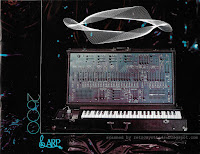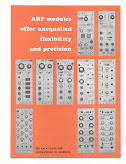Thursday, December 31, 2020
ARP 2600, Omni-2, Piano and Quartet infosheets, 1979
ARP "From Jimmy With ARP" advertisement, Downbeat Magazine 1974
ARP "From Jimmy With ARP" half-page black and white advertisement from page 41 in the June 20, 1974 issue of Downbeat Magazine.
Well, look at this! I hope you are noticing the trend. As part of trying to get all my 2020 ARP 50th anniversary celebration posts... eeer... posted, I've been uploading quite a few ARP pieces this month, including two of the many ARP advertisements from the time period that used a very similar half page, black and white format.
And now... I've posted the third. With more to come.
I love that all three of these ads all fit into a theme, but yet they are all very distinguishable from each other. There isn't a stagnant "photo/artwork at top" - "text in the middle" - "Logo in bottom right" format to them. Each of the ads has kept a unique look. As unique as the different artists that are featured in each one.
One other thing I like about all three ads is they all contain one of those little cookies I went on about in my last Carpenters ad. This earlier ad uses the code "DB-620" (Downbeat June 20), but curiously leaves out the "year", unlike that those other 1975 ads included (DB 1-16-75). Looking at a few of the other earlier ARP ads like the Edgar Winter ARP ads that appeared around six months earlier, they too used the earlier cookie format that didn't include the year. No real other comment to make on that fact - just interesting that they changed the format.
Another little thing that separates this earlier ad from the others is the little picture in the bottom right hand corner of three of ARP's products. This little photo also appears in Edgar Winter's Frankenstein and Freeride ARP ads, but not in Billy Preston's Space Race ARP ad or Stevie Wonder's WonderArp ad (none which I've posted yet). Once I've mapped out the timeline for all these half-pagers, it will be interesting to see when exactly they were added and removed.
My past experiences of 'Zep run along the same lines of The Who. I didn't really understand or 'get' the synth influences first time around. The one thing I do notice when looking back, is that fans of Townsend were much more accepting of the band's use of synthesizers where Led fans weren't so sure they shared their favourite band's love for them. Just my observation - your mileage may vary.
Now, where deeper knowledge of most Zeppelin songs flew over my head (except for the mandatory ever butt-grabbing Stairway to Heaven), there was one song I was always willing to get behind...
Carouselabra.
For some reason I've always had an affinity for that one. Maybe it was the synths that first got me hooked? Maybe? It could also have been that some of the dreamier parts reminded me of Alan Parson's stuff. I dunno. Hard to say. But I can tell you when the topic of Led Zeppelin came up with friends at a party, I would turn the convo towards that song, and trying to convince them to play it on whatever stereo system was handy.
Just for fun, I googled the song to see what others had to say, and this rather interesting post on Cheatsheet.com came up - "What Robert Plant Regretted About Led Zeppelin’s ‘Carouselambra’". It takes a little bit of a deep dive on the lyrics of the song.
Go Cheatsheet! Go Carouselabra!
And okay... go Stairway to Heaven!
Thursday, December 17, 2020
ARP "Meet the Carpenters new string ensemble" ad, Downbeat Magazine 1975
ARP "Meet the Carpenters new string ensemble" black and white advertisement from the March 27, 1975 issue of Downbeat Magazine 1975.
Tuesday, December 15, 2020
ARP "Pete's ARP Opera" half page advertisement, Downbeat Magazine, 1975
ARP "Pete's ARP Opera" black and white advertisement from the June 5, 1975 issue of Downbeat magazine.
I'm betting that Pete's face sold a lot of synths for ARP.
If you were familiar with The Who... Pete Townshend... or ARP Instruments at the time, you definitely had come across this image in the media. It was everywhere - including this ARP advertisement in Downbeat. Prior to 1976 there weren't a lot of synth magazines to promote your synth products. So Rolling Stone and Downbeat were two magazines that managed to hoovered up more than a few advertising dollars from synth companies.
Let's face it, ARP loved using endorsements as a marketing tool, so when Pete sent promotional photos of himself with his ARP synths to them, it was a match made in heaven. Not sure I can call it serendipity... but it's something.According to ARP's own Arpeggio newsletter from April 1974, the original "outrageous self-portrait of Pete Townshend with his ARP 2600 has appeared in dozens of magazines, including Penthouse, Downbeat, Crawdaddy, Rolling Stone, Cream, and many others. Pete presented this photo to ARP about two years ago, and it has really made the rounds".
No kidding. That quote also provides us with an estimated date the photo was taken - that issue of Arpeggio came out in April 1974... and two years earlier would have been around 1972. And that 1972 date is confirmed through other sources too. Nice.
And then three years later that photo showed up in this ad for ARP. That's a pretty good shelf life.
Back in my early days, I was familiar with The Who mostly because a few of my friends considered themselves Mods during that culture blip in the 80s. It was one of those bands I listened to, but never really picked apart or dove too deep. As a result I never really tuned into the fact that Townshend was such a synthhead. But as I got older and started hanging out in Usenet groups like rec.music.synth, I became aware just how synth-heavy the band was. Baba O'Riley. Who Are You. Won't Get Fooled Again. So many familiar songs.
I guess my point is... I want to squeeze the cheeks of this face.
If you want to see a lot more of Pete and his synths, in particular his ARPs, check out the "The Electronic Music of Pete Townshend" page on Petetownshend.net. Lots of great stuff there.
Side note: the same site came out with a nice little post when Korg reissued the 2600 early in 2020 - it has some good bits about Pete and the use of the the ARP synths, including the Reverb feature video on the 2600 that came out at the time as well. Which of course includes a few of RetroSynthAd's ad and brochure scans!
Friday, December 11, 2020
ARP Literature Order Form, 1975
"A dummy plug is just a plug with no cable attached. I remember seeing one in Automatic Gainsay's videos on YouTube, where he was demonstrating the ARP 2600. Most of the internal connections on the 2600 are normalized (which is why it's considered a semi-modular). If you want to break one of those internal connections, but don't actually want to patch something else in, you just insert a dummy plug to bypass the normalized connection."
Wednesday, December 9, 2020
ARP "The Arp Story" brochure, 1974
"We offer an exclusive series of instructional programs, playing guide songbooks, and cassette tape packages designed specifically for ARP synthesizers."
Friday, September 4, 2020
ARP 2500 modular "The ARP electronic music synthesizer" brochure and mail-in insert, 1970/71
 So, for example, the front page of this September 1972 "The ARP 2500 Electronic Music Synthesizer" brochure on the Internet Archive has the same image, but the title is slightly different, it includes the new more familiar treble clef ARP logo instead of the older Tonus/ARP logo, and it has the later Needham street address at the bottom (see image at right).
So, for example, the front page of this September 1972 "The ARP 2500 Electronic Music Synthesizer" brochure on the Internet Archive has the same image, but the title is slightly different, it includes the new more familiar treble clef ARP logo instead of the older Tonus/ARP logo, and it has the later Needham street address at the bottom (see image at right). 
























































